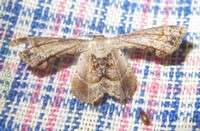Phazaca
Phazaca is a genus of moths in the family Uraniidae first described by Walker in 1863.
| Phazaca | |
|---|---|
 | |
| Scientific classification | |
| Kingdom: | |
| Phylum: | |
| Class: | |
| Order: | |
| Family: | |
| Subfamily: | |
| Genus: | Phazaca Walker, 1863 |
| Synonyms | |
| |
Description
Palpi upturned, reaching vertex of head. Antennae thickened and flattened in male. Forewings broad. The outer margin evenly curved. Vein 5 from below the upper angle of cell and veins 6,7 and 8,9 stalked. vein 10 from cell. Hindwings usually with the outer margin produced to points at veins 4 and 7, slightly developed in male. Vein 5 from the middle of discocellulars. Veins 6 and 7 from angle of cell or shortly stalked. Male with a fold on inner area containing a tuft of long hair, veins 1b and 2 being distorted. Wings held more or less apart in repose.[1]
Species
- Phazaca acutilinea (Warren, 1897)
- Phazaca alikangensis (Strand, 1917)
- Phazaca cesena (Swinhoe, 1902)
- Phazaca cesenaleuca Holloway, 1998
- Phazaca conifera (Moore, 1887)
- Phazaca coniferoides Holloway, 1998
- Phazaca cyclocrossa (Turner, 1926)
- Phazaca cythera (Swinhoe, 1902)
- Phazaca decorata (Warren, 1898)
- Phazaca erosioides Walker, 1863
- Phazaca interrupta (Warren, 1896)
- Phazaca kellersi Tams, 1935 (from Samoa)
- Phazaca leucocephala (Walker, 1863)
- Phazaca leucocera (Hampson, 1891)
- Phazaca lugens (Warren, 1897)
- Phazaca monticesena Holloway, 1998
- Phazaca mutans (Butler, 1887)
- Phazaca perfallax (Warren, 1898)
- Phazaca planimargo (Warren, 1906)
- Phazaca rhombifera (Warren, 1897)
- Phazaca stolida (Butler, 1886)
- Phazaca theclata (Guenée, 1857)
- Phazaca unicauda (Dudgeon, 1905)
- Phazaca unicaudoides Holloway, 1998
gollark: Always make sure that your variables are global and that everything is represented as strings.
gollark: There are backwards-incompatible changes sometimes, but usually smallish ones.
gollark: Yep. Mostly.
gollark: (in newer versions only mind you)
gollark: Of course, a `startup` folder will already do that in CraftOS...
References
- Hampson, G. F. (1895). The Fauna of British India, Including Ceylon and Burma. Moths Volume III. Taylor and Francis – via Biodiversity Heritage Library.
- Savela, Markku. "Phazaca Walker, 1863". Lepidoptera and Some Other Life Forms. Retrieved August 1, 2018.
This article is issued from Wikipedia. The text is licensed under Creative Commons - Attribution - Sharealike. Additional terms may apply for the media files.